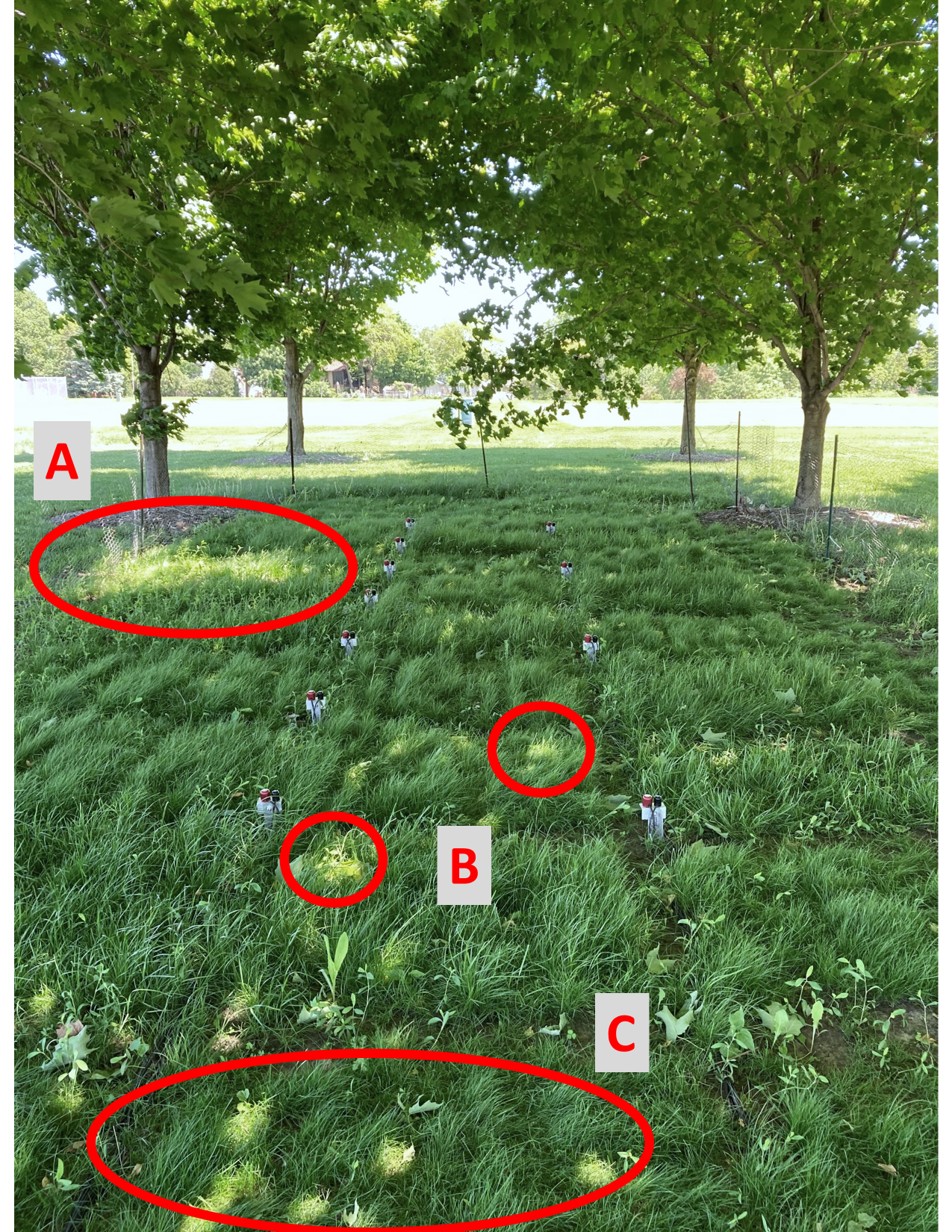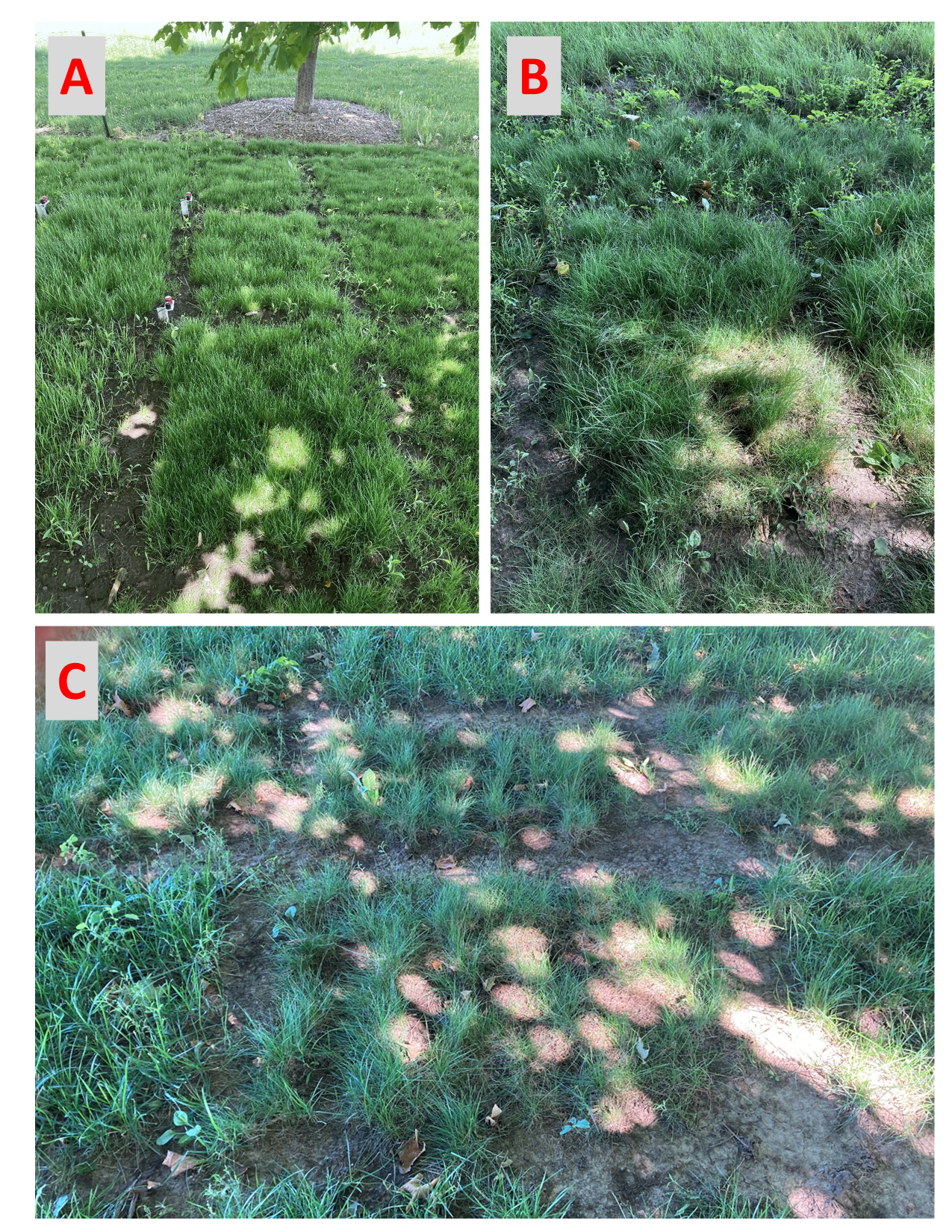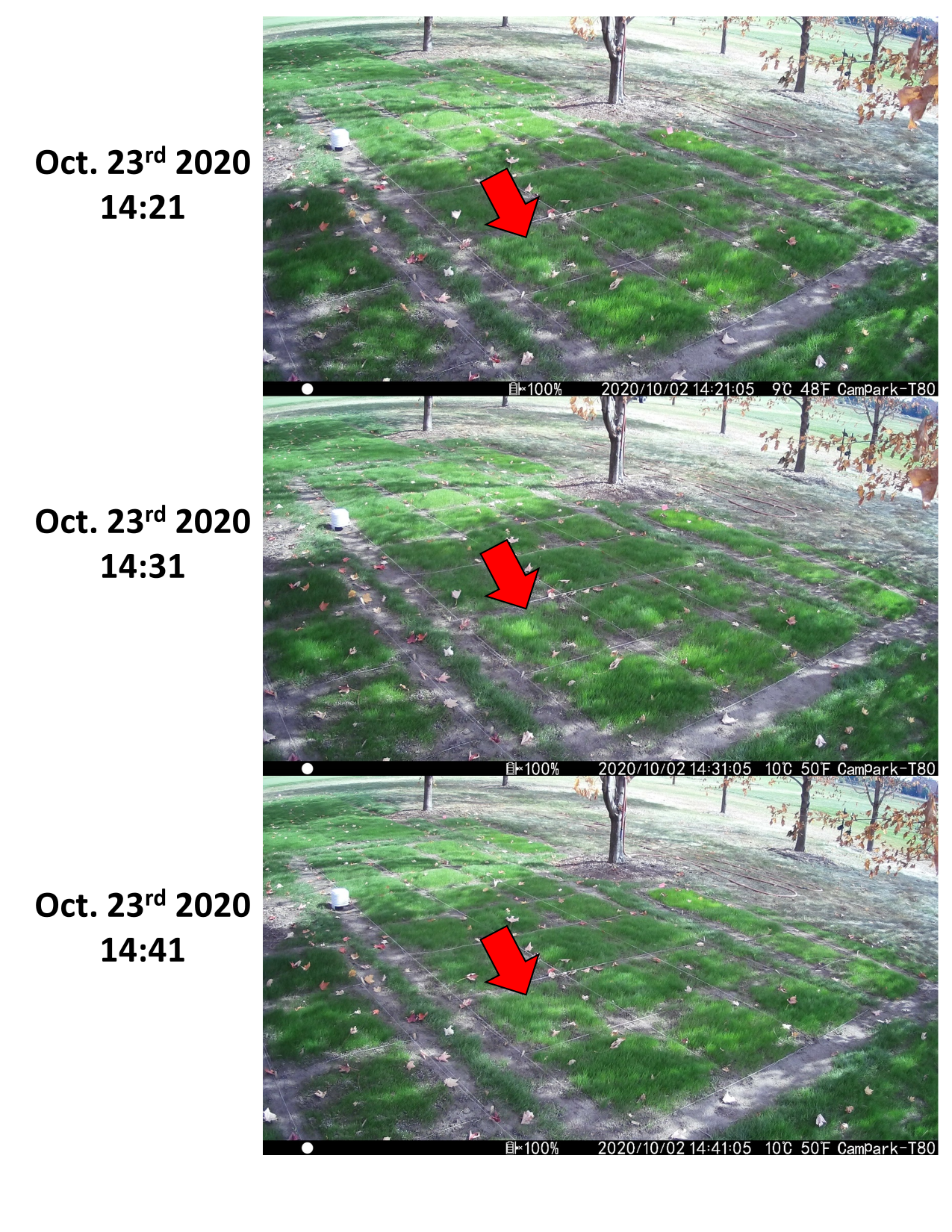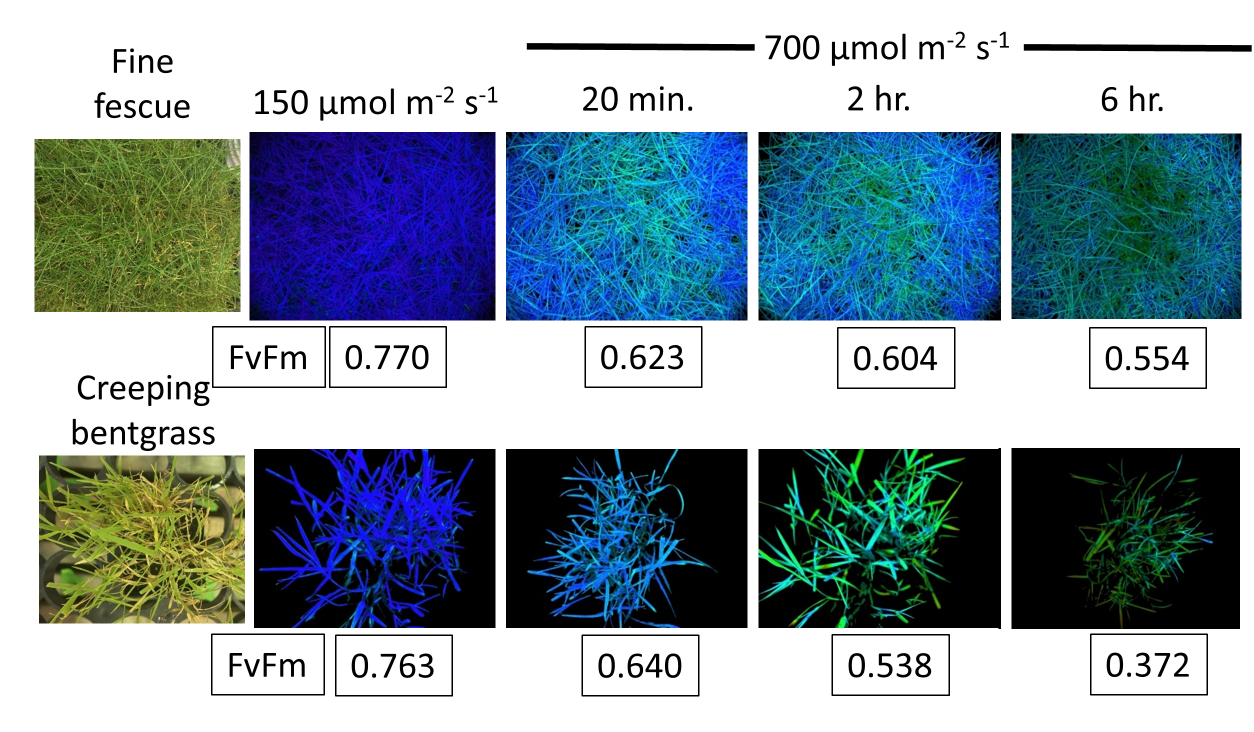By Dominic Petrella
When we think about turfgrass shaded by trees we as researchers often focus on reductions in light intensity, reductions in the red to far-red ratio (R/FR ratio) along with other changes in spectral quality, competition for water and mineral nutrients, and alterations to temperature compared to full sun environments. However, another challenge for turfgrass plants under shade is exposure to sunflecks.
Sunflecks are “patches” of relatively brief (microseconds to minutes) increases in light intensity in areas that are normally shaded (Figure 1). Sunflecks occur due to gaps between trees and gaps in the leaf canopy from leaf/branch patterning where direct sunlight is able to penetrate to the ground when the sun is at a particular angle.
Sunflecks are unique in shape and size (Figure 2), they can be different from day-to-day, and wind can cause extreme fluctuations in their appearance. Change in sun-angle over the course of the day and the year, results in sunflecks appearing at different locations at different times of the day. On Monday, a sunfleck may appear at “point x” at 11:10, but a week later it could be moved by a few feet away because the sun angle has slightly changed. Furthermore, the sunfleck may only last for 5 minutes because of change in sun angle over the course of the day, or the sunfleck may rapidly fluctuate from wind (Video 1). Sunflecks may also be different in subsequent years due to different position of leaves, new leaves, and due to new/lost branches that all change the overall tree canopy. This inconsistency is what makes sunflecks a potential challenge for turfgrasses, and especially a challenge for those who research shaded turfgrasses.
Video 1. On windy days, sunflecks and can last for microseconds, leading to the plant being exposed to very low light and relatively high intensity light back and forth over minutes.
Video 1
In sunflecks, light intensity may increase by 10-20x, going from 50 µmol m-2 s-1 or less (90-100% reductions in light compared to full sun) all the way to 1,000 µmol m-2 s-1, then back to low light intensity within seconds to minutes. The range in sunfleck light intensity is highly variable from fleck to fleck and from site to site. Because of the nature of sunflecks, turfgrasses separated by inches could be growing under completely different conditions (Figure 3).
Sunflecks can make it even more difficult to research the management of shaded turfgrasses, or to examine variation in species/cultivar performance of real-world tree shade. This is primarily because some plots may receive brighter, longer-lasting sunflecks, or no sunflecks at all. If some grasses or treatments perform differently in this example, it could be due to the sunflecks and not from the treatments being examined. It can also be difficult to quantify sunflecks, in both location, timing, and change in light intensity (Video 2).
Video 2. Quantifying light intensity in shade experiments can be difficult due to the placement of sensors to measure photosynthetic photon flux (PPF). A sensor may not be in a sunfleck, or could just be on the edge of the sunfleck, therefore not taking into account changes in light intensity in the plot or the entire area.
Video 2
This coming year, we will be using time-lapse photography to help us identify where, when, and how long sunflecks last in our field plots (Figure 4). This will help us to determine if sunflecks are part of the cause of turfgrass dieback, and will aid us in determining where sensors should be placed to better measure and quantify changes in light intensity within sunflecks.
Now the ultimate question, are sunflecks good, bad, or of no consequence? I think that most people would think that additional light to shaded plants would be good thing, but that might not always be the case. This summer while taking data under a shade trial, I started to notice over a few weeks that areas that were receiving sunflecks tended to be bare and/or dying back (Figure 5). This could be a complete coincidence and a perfect example of correlation doesn’t mean causation, but the sheer number of dead areas of turf that were associated with sunflecks provides for a researchable question: can sunflecks stress and damage shaded turf?
Researchers have questioned and evaluated plants exposed to the fluctuating light intensities that occur with sunflecks for decades, but there is less research on the topic than I actually expected. Sims and Pearcy (1993) grew Alocasia macrorrhiza plants under low light or low light with sunflecks; plants received the same amount of light over the day. Their results showed that plants receiving most of their light via sunflecks produced 80-90% less biomass than plants under constantly low light. However, plants under constantly low light and under fluctuating, sunfleck, light had the same capacity for photosynthesis…all of the plants should have been able to have similar amounts of photosynthesis.
While the results of Sims and Pearcy (1993) have been contested and debated, I haven’t run across other studies that have looked at plant growth (biomass) under sunflecks; most have measured photosynthesis or examined gene expression only. We want to measure turfgrass growth under these conditions as well, because, in the end, this is what will indicate to what extent sunflecks benefit or damage the shaded turfgrass.
Still, why might sunflecks cause damage and decrease growth? Slattery et al. (2018) summarized the answer to this question well…
- When transitioning from low to high light, the rate of photosynthesis will be limited by whether or not stomata are open to let in CO2. If stomata are not open or are slow to open in response to higher light, the plant may not be able to take advantage of the higher light to perform more photosynthesis.
- Photosynthesis is a set of chemical reactions that rely on enzymes. These enzymes are not always present, and if they are they might not be in an active state. If the plant takes a lot of time to produce more of these enzymes or activate these enzymes, the plant may not be able to take advantage of the higher light to perform more photosynthesis.
- Last but not least, as soon as the plant is challenged by higher than normal light intensity, leaves may got into a state of photoprotection. The process of photoprotection is a normal response to high light intensity, excessive light can be stressful. The length of time the plant stays under photoprotection may limit the amount of photosynthesis, and the plant may not be able to take advantage of the higher light to perform more photosynthesis.
We can examine point (3) by measuring the photochemical efficiency (or Fv/Fm) of leaves to help us determine if the leaves are experiencing photoinhibition (the inhibition of photosynthesis by light). When both fine fescue and creeping bentgrass plants were growing under relatively low light intensity (150 µmol m-2 s-1),photochemical efficiency was near optimum (FvFm ≈ 0.800; Figure 6). However, after these plants were transferred to higher light (700 µmol m-2 s-1), photochemical efficiency continued to decline, with no signs of stabilizing (Figure 6).
These results indicate a few things…1) turfgrasses are stressed when challenged with high intensity light when they normally grow at low intensity light, 2) this stress lasts for a relatively long period of time and gets worse over time, 3) if exposed to a sunfleck, these preliminary results, suggest that it could do more harm than good, as the leaves show no sign of acclimation over hours.
Conclusions
There are more questions than answers on this topic, which is a great thing for a researcher. We do have some preliminary information though that will help us to develop more specific experiments, using what we currently have learned.
- Sunflecks occur, and light intensity can dramatically increase in these spots for a short period of time before going back to lower light intensity.
- Turfgrasses that are growing under low light are stressed when challenged by a period of higher intensity light. Sunflecks last for a short period of time, and turfgrasses transferred from low to high light intensity were stressed for a period of time that lasted much longer than a sunfleck would.
- In the field, turfgrass areas with patchy sunflecks, also have patchy dead areas of grass.
References
Sims, D.A., and R.W. Pearcy. 1993. Sunfleck frequency and duration affects growth rate of the understory plant, Alocasia macrorrhiza. Functional Ecology, 7, 683-689.
Slattery, R.A., B.J. Walker, A.P.M. Weber, and D.R. Ort. 2018. The impacts of fluctuating light on crop performance. Plant Physiology, 176, 990-1003.



